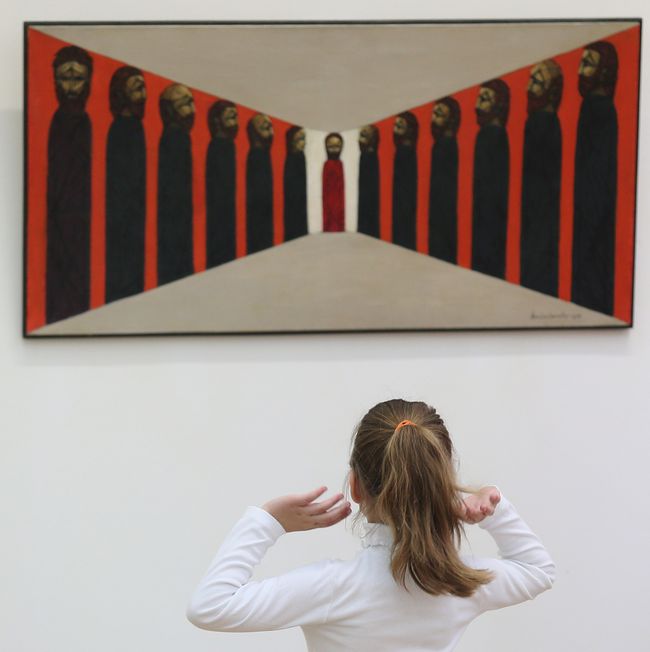The ordinary miracles of Jacques Hnizdovsky
Kyiv hosts an exhibit of the famous graphic artist’s works
The National Art Museum of Ukraine (NAMU) launched a project the other day to mark the birth centenary of the Ukrainian-American artist Jacques Hnizdovsky. The exposition comprises about 150 artworks by the master from the collections of the NAMU, the National Andrei Sheptytsky Museum of Lviv, and the Ukrainian Catholic University, as well as the private collections of Pavlo Gudimov, Lydia and Petro Matiiashek, Viktor and Kateryna Yushchenko, etc. These include both graphics, particularly bookplates, and paintings. The NAMU prepared this high-profile project in conjunction with the United States Embassy in Ukraine, the Ministry of Culture, and the Open Ukraine foundation.
Jacques (Yakiv) Hnizdovsky was born in 1915 in the village of Pylypche, now Ternopil oblast. The artist studied at the Warsaw and Zagreb art academies and won fame in the US, where he lived since the 1950s. The master was always emphasizing his origin and inquiring about the events in Ukraine and willed to be buried in his fatherland. The artist died in 1985 in New York and was buried in America. In 2005 the urn with his ashes was reburied at Lviv’s Lychakiv Cemetery.
The emigre artist was almost unknown in Ukraine until recently. “Incidentally, his artworks appeared in the NAMU’s repositories at the same time when museum documents began to be written in Ukrainian rather than in Russian, as before. This occurred in late May 1990,” says Danylo Nikitin, NAMU graphics section chief, curator of the Jacques Hnizdovsky exhibition. Still, the graphic artist has been mostly known in the “narrow circles” of art appraisers in the past 25 years. Nikitin explained why it is worthwhile to see the Jacques Hnizdovsky project in Kyiv.
SCALE
The National Art Museum exhibit is the largest-ever display of Hnizdovsky’s artworks in Ukraine. Although this project was presented in Lviv and Chernivtsi and will be shown in Dnipropetrovsk and Cherkasy, the NAMU has collected the largest number of the artist’s works.
Incidentally, one can not only watch, but also read the famous graphic artist’s works. Hnizdovsky was also a philosopher and a culture expert. According to Nikitin, Hnizdovsky’s essays and text collections were published in US and European journals. Naturally, museums do not display this kind of materials, but they are accessible in the Internet. These texts are reflections on worldwide, and above all Ukrainian, art.
A UNIQUE FILM
The NAMU exhibit presents a mid-1960s video which shows Hnizdovsky working on the woodcut Two Rams. Next to the video set hangs the work the artist is doing in the film. Hnizdovsky applied the unique technique of woodcarving, in which the first European engravings were created. Masters would make a drawing on a woodblock, then remove the wood, and make an imprint on paper. Hnizdovsky showed interest in this technique in a young age under the influence of the legendary artist Albrecht Duerer. The latter’s famous series “Apocalypse” was made in the woodcarving technique. In the course of time, Hnizdovsky improved and updated this technique. The master worked out a style of his own full of ornamental and decorative beauty.
AMAZING HARMONY
Jacques Hnizdovsky often depicted animals and plants. In New York, he lived near the Bronx Zoo, where he strolled, watched and drew animals. “All the surrounding things constituted an undeniable value for Hnizdovsky. Animals, trees, people, plants, and architecture – all this seems to have been blessed and to be asserting its right to exist. This is a pantheistic view of the world,” Nikitin says. The master’s affectionate attitude to ordinary things, harmony in the routine life, and a light irony are really impressive. So, come and see the exhibit of Jacques Hnizdovsky’s artworks, which will remain open at the National Art Museum of Ukraine until July 5.
Newspaper output №:
№35, (2015)Section
Time Out





